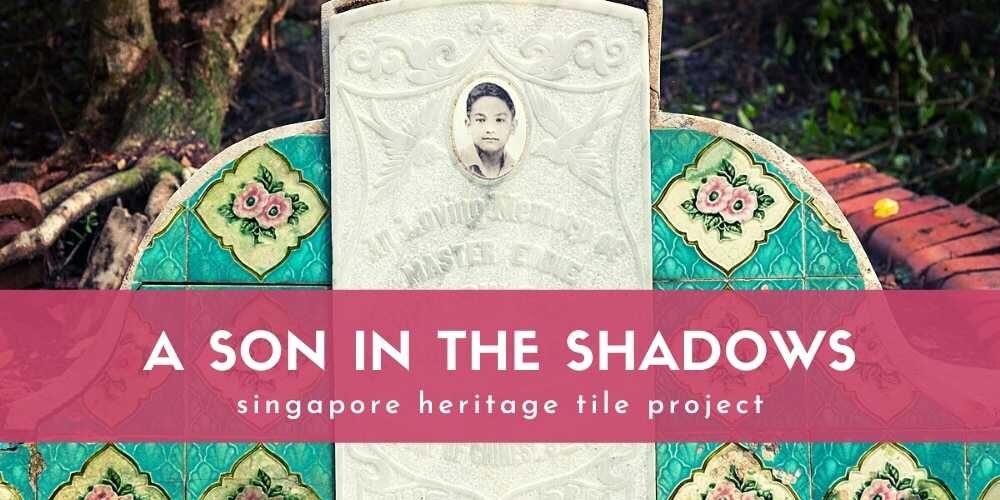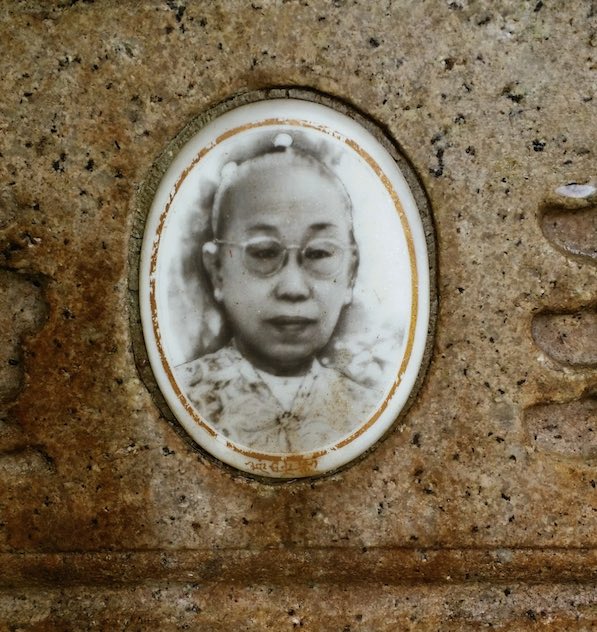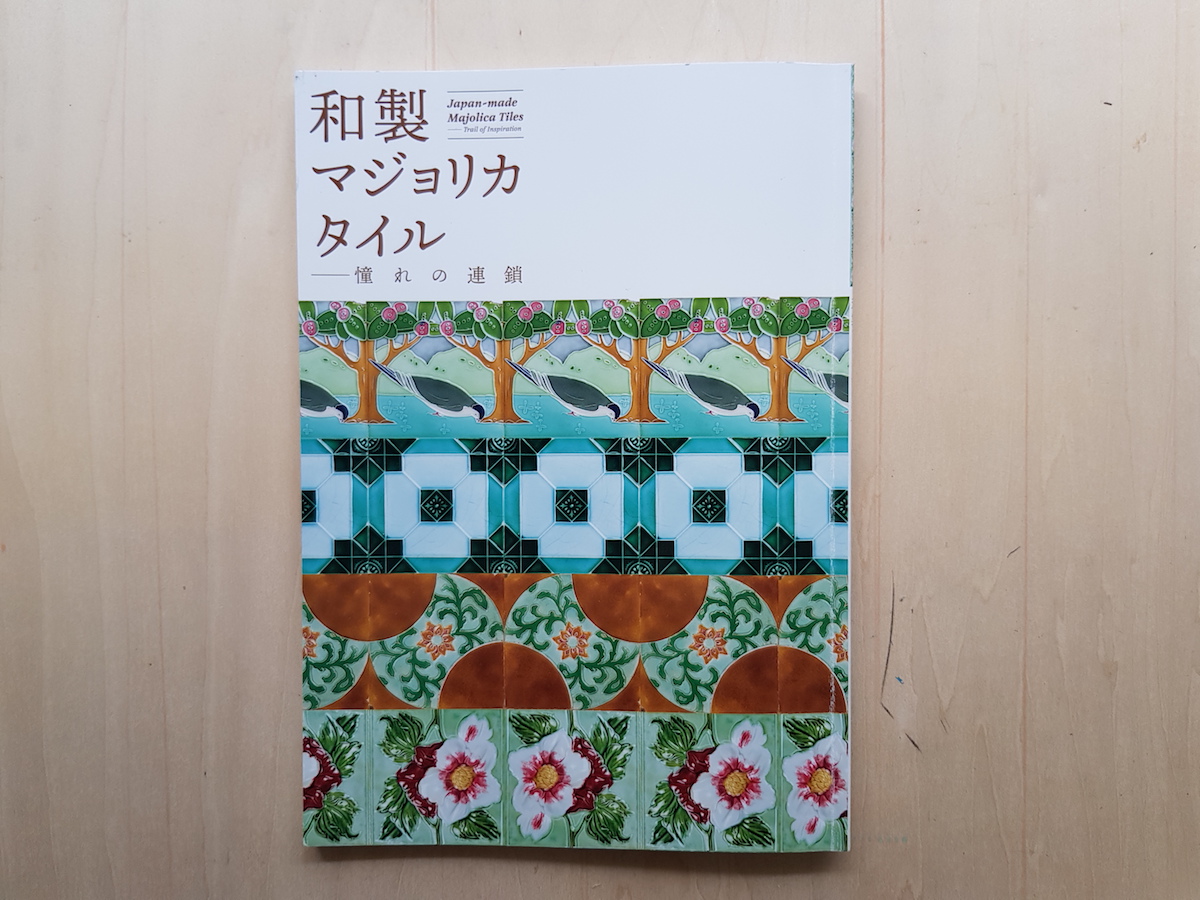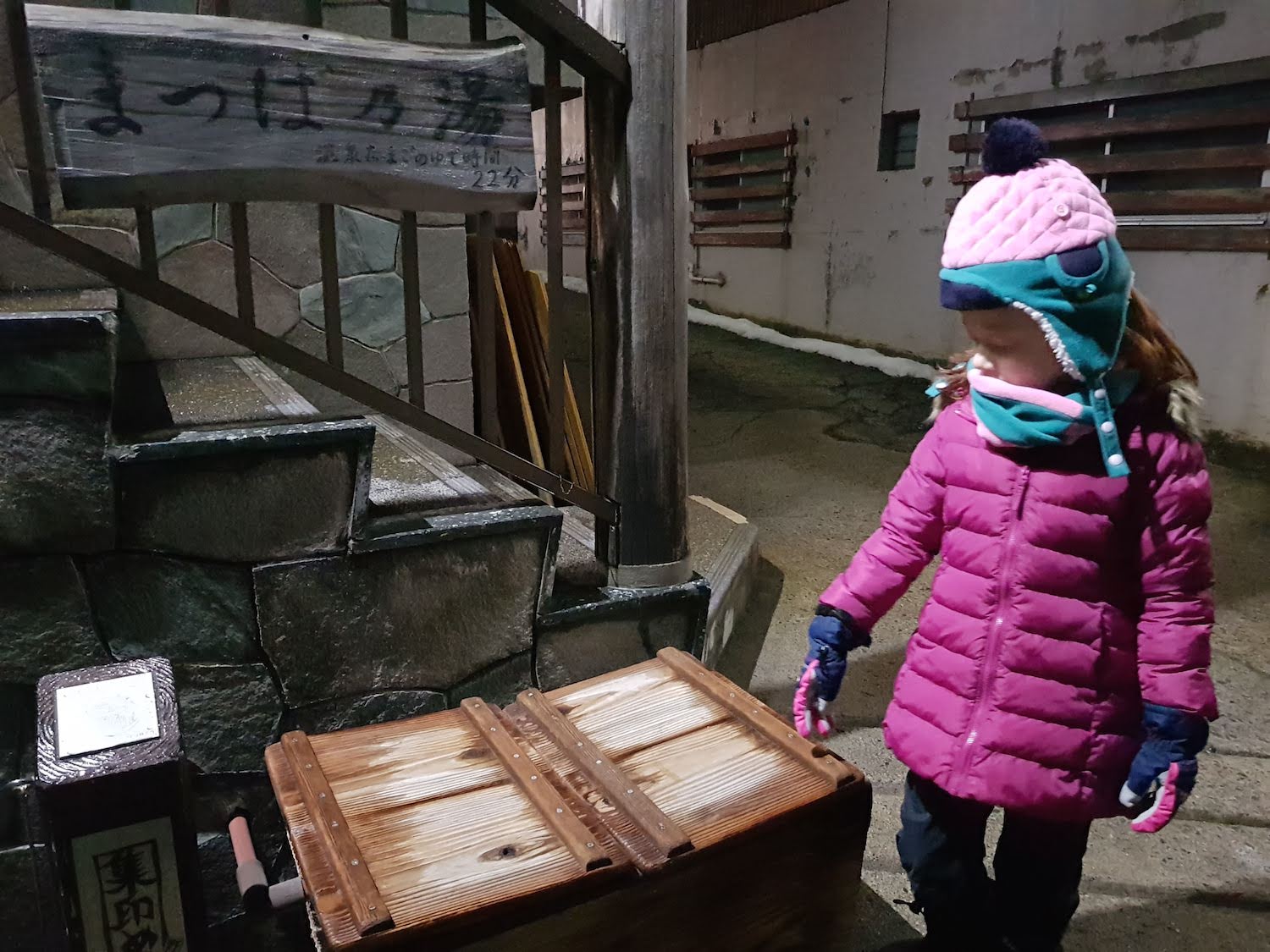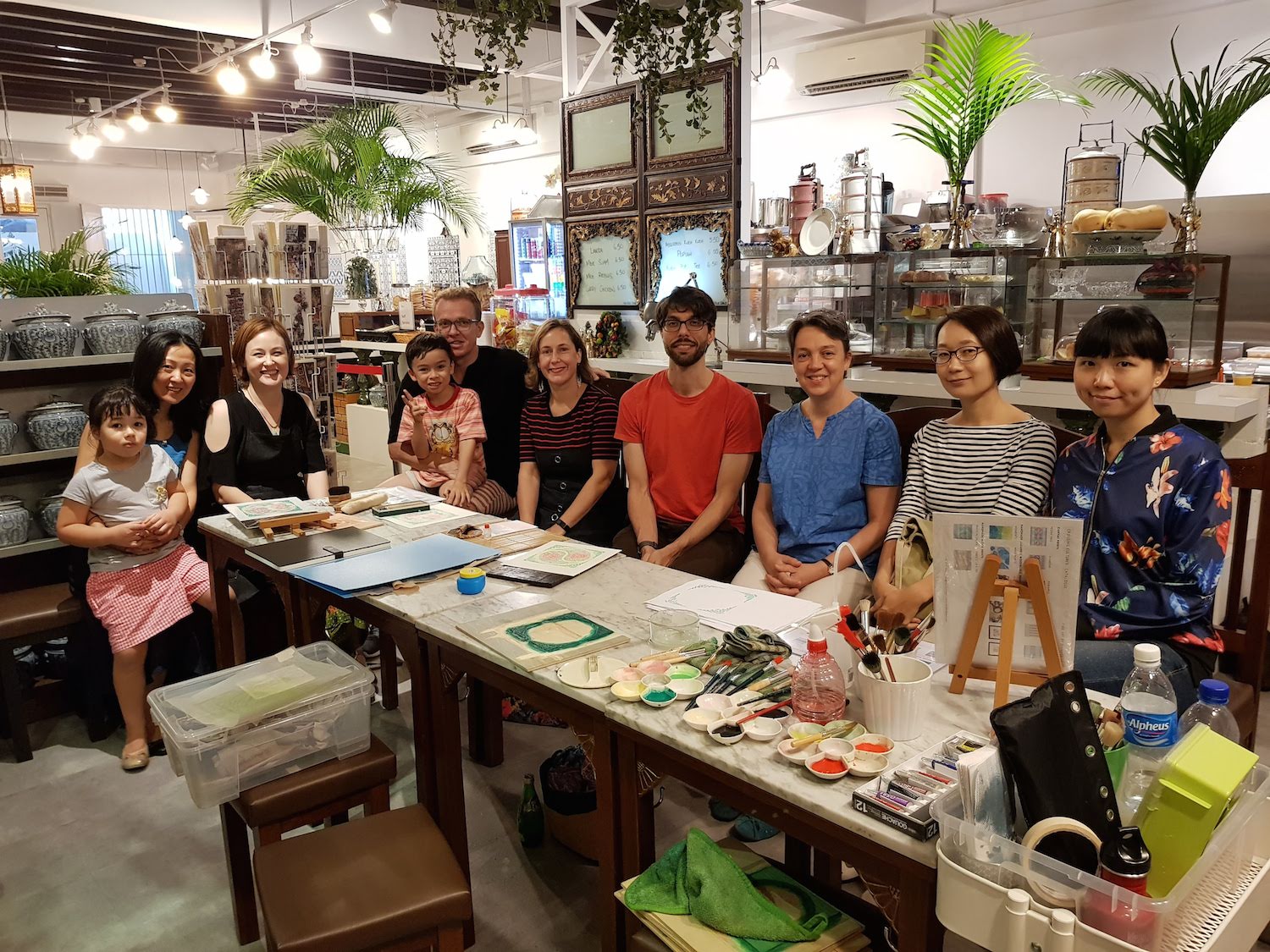A school boy smiles softly, his portrait capturing a precious moment of youth. Eddie Chan Sin Chuan’s image looks out from the delicate cascade of pink roses and emerald scallops. His colourful tomb suggests life and vigour, however, he was buried during Singapore’s darkest era.
Read MoreMy Great-Grandfather's Clan House
Passage, a magazine published by Friends of the Museums Singapore, featured an article about my great-grandfather’s clan house in Singapore. Read the PDF version
Straits Times Feature: Secret Singapore
Delighted to have assisted Heidi Sarna with her entry on decorative tiles in her upcoming book with co-writer Jerome Lim, ‘Secret Singapore’. This book sounds really exciting and proves that there are still many interesting pockets around Singapore!
Read MoreSingapore's Vintage Tiles: An English Affair
The tropical jungle of Singapore forms the backdrop for an international love affair with England.
Read MoreANZA Seminar: Secrets of Bukit Brown Cemetery
Lots of fun had in sharing some of Singapore’s rarest vintage tiles and their international connections to ANZA members! In a 30-minute seminar, I introduced members to some of Singapore’s ‘Peranakan tiles', century-old ceramics representing Chinese traditions, overseas influences and local trends, as well as my personal connection to Bukit Brown Cemetery.
Read MoreBukit Brown Cemetery: A Vintage Tile Guide
Read this guide to learn more about the exquisite vintage tiles at Bukit Brown Cemetery, Singapore.
Read MorePeranakan Tiles: Peacocks on Parade
Read more about vintage peacock tiles at Bukit Brown Cemetery, Singapore.
Read MoreLandscape Tiles: The Mysterious Latecomers
One of the many mysteries of Singapore’s tiled heritage are landscape tiles. I’ve come across several at Bukit Brown Cemetery, and some of the nearby cemeteries in the area.
Read MoreBukit Brown Cemetery: My Family Connection
I never imagined that a Chinese graveyard would be at the heart of my family tree research. The unexpected exhumation of my great-grandfather in 2012 revealed my personal link to Bukit Brown Cemetery. This event sparked my interest in one of Singapore’s most unusual commemorative spaces and uncovered other connections to both my Hokkien, Peranakan and Eurasian heritage, and to other places in Singapore.
Rediscovering my Peranakan great-grandparent’s tomb
With the help from my extended family and ‘Brownie’ members of cemetery’s volunteer guide group, I’ve since uncovered the graves of four other relatives. These include my great-great-grandfather from southern China, my great grandmother (who is also first wife of my great grandfather!), and my Chinese Peranakan great-grandparents. It's taken me several years just to get these details straight!
Visiting my Hokkien great-great-greatfather’s tomb during the annual Ching Ming tomb cleaning ceremony
My surname reveals my Hokkien ancestry, and I never gave it much thought till I stood in front of my great-great grandfather’s tomb. I suddenly saw myself as part of a long line of relatives descending from China, and it felt both strange and wonderful. Born in 1855, Lim Hong Eok braved the seas between southern China and Singapore in the 1880s with his two sons, Lim Nee Yam and Lim Nee Chip. He died in 1934, and his tomb records his life story along with the inscription of his many descendants. Whether he had plans to eventually return to his ‘motherland’, I’m not sure, but some say he unable to return due to trouble with neighbours in his home town.
The tomb of my great-grandmother, with lovely floor tiles.
You've heard about those stories of Chinese and their multiple wives? Yes, it certainly happened in my family too! Madam Yang Tang Ho had seven children and one of them was my grandfather, Lim Chong Lay. There were two other wives, who ended up having three other children between them. I'm really not sure how my great-grandfather Lim Nee Yam handled it all, but apparently, he was a very generous and easy-going personality.
My Chinese Peranakan great-grandmother Ong Leong Neo
My father’s Chinese Peranakan side has been of particular interest to me as it is a hybrid sub-cultural group in countries such as Singapore, Malaysia and Indonesia. I was thrilled to discover my great-grandmother’s tomb in 2014, and re-discovered it recently after confusion caused by nearby construction of a highway. After several hours looking for it in the heat, I ended up asking a cemetery caretaker to find it. Sure enough, I had a happy text message the next day informing me about its whereabouts!
A very popular peacock tile imported from Japan on the tomb of Ong Leong Neo, my Peranakan great-grandmother.
My father has always strongly identified as a Peranakan, and I was interested to see my great-grandmother dressed in a Kebaya blouse with a Sanggol hairpin to keep her tell-tale bun in place. I was also amazed to find decorative tiles featuring peacocks, flowers and landscapes on her tomb, as well as on that of her husband next door, Tan Teck Yam (1874-1936). Until then, I’d only thought that people decorated their shophouses with these imported tiles, and was surprised to find quite a few beautiful and unsual tiles at the cemetery.
A landscape tile panel on my the tomb of Tan Teck Yam, my Peranakan great-grandfather
The twin tomb of my Peranakan great-grandparents is inscribed with both Chinese and English lettering, which usually means that the deceased or descendants felt an affinity with English, or were schooled in English. I have recently come across Chinese tombs that have only English inscriptions. My own father was educated in English, although he did attempt several weeks at a Chinese primary school before he ran away screaming…or so I’ve been told!
My great grandmother Ong Leong Neo. My mother reckons I look like her...what do you think?!
If you’ve just started looking into your family history, you’ll know the great feeling you get when you start to ‘join the dots’. Particularly as a person from a ‘mixed marriage’, it’s nice to uncover my heritage even if I don’t exactly look like my ancestors (local kids still try to ‘wipe’ off my freckles). For the sake of my kids and my invalid father, I’m glad I’ve been able to find out more about my past. I hope you get the chance to know more about your own roots too.
The next generation admiring tiles!
Share the Love! If you’ve enjoyed reading this blog, please leave a comment below. Feel free to use the ‘share’ button below to help others connect to culture.
Peranakan Tiles: The Japanese Connection
Peranakan tiles, as they are now often called in Singapore, have symbolised a love of foreign design for over a century. With their bright colour palette and bold motifs, these heritage gems are often assumed to be of European origin due to their gentle and classical designs. So it’s a surprise to find out that many popular designs in Singapore were made Japan! Why is this the case?
A very popular ‘high relief’ Japanese tile with English design origins
Japanese tiles entered the global tile market for a short but very active period between WWI and WWII. Although it might seem natural for Japan to export ceramics due to their long history of beautiful creations, it took some time for the nation to transition from the traditional hand-made way of producing ceramics to modernised methods involving machinery and new types of chemicals.
The same floral tile on the bottom row of this catalog about Japanese tiles.
In fact, Japan turned to foreign consultants such as German-born scientist and educator Gottfried Wagner to help fast-track things. Dubbed the ‘father’ of modern Japanese ceramics, Wagner was invited to Japan in 1868 to work for an American trading company. He quickly moved onto his true calling as an educator and researcher, and successfully trained the first generation of Japanese technicians in tile technology.
Enjoying this blog post so far? Become a supporter to continue reading
Meet The Maker: What's In a Name?
My trilingual business card…it sometimes become a great way to start a conversation!
Hi, I’m Jennifer. I actually have a Chinese name, but no-one in my family ever knew how to write it. When I moved to Singapore in 2012, a local friend proficient in Chinese gave me some characters to match the sound of my name. Voila! Sounds simple, right?
Firstly, you might be thinking that it’s strange that no-one bothered to record my name in the first place. True, even a scrap bit of paper would have been helpful. But the truth is, my father never learnt to read or write Chinese. How could a Chinese from Singapore not know Chinese?
The bilingual education system (meaning Mandarin Chinese and English) was introduced in Singapore primary schools in 1960. For high schools, it was introduced in 1966. So my father, born in 1948, missed out on the chance to study Mandarin. Some people debate the calling of Mandarin a ‘mother tongue’, since so many families speak their own dialect, whether it be Teochew, Cantonese or Hakka. My paternal grandfather’s family spoke only Hokkien.
The ‘baby’ language spoken by my dad with his mother was Baba Malay - a kind of pidgin Malay with some Hokkien words thrown in, I believe. Growing up in the village of Chai Chee near Kembangang, he presumably spoke Malay to many of his neighbours. In recent years, I’ve attended a few plays held in Baba Malay, and I am surprised by its richness and strangely, sense of familiarity for me.
Apparently, there were attempts to send my father to Chinese school, which his older stepbrothers and sisters were attending. These older siblings were the offspring of my grandfather and the first wife, who were both Hokkien. After six months, he called it quits, according to my mum. I suppose the school was overly strict or just too culturally unfamiliar.
When I was in high school, I distinctly remember asking my dad to write my Chinese name. I was sent away with a flea in my ear and decided it was safer to wait for the chance to ask someone else. Since moving to Singapore, I’ve met a few Peranakan aunties and uncles with the same sort of experience as my dad. It would have been nice to tell him that being unable to read or write Mandarin was not something he should feel insecure about.
So finally in my early 40s, I'm pleased to be able to present my business card in English, Chinese and Japanese. Knowledge is power, or for me, it feels like knowledge is a comfort. I may never be able to speak Mandarin or Hokkien, but at least I can now finally write the name given to me by my grandparents. And what is it, you may ask? Lim Wei Mei, or 林 薇美. Lim means ‘grove of trees’, Wei means ‘a rose’ and Mei means ‘beauty’.
And for the mix, you can also address me as ‘Nyonya Jennifer’ to acknowledge my Peranakan side. It’s a very long-winded multicultural world when you dig into it!
Meet The Maker: The Japanese Connection
Looking a bit ‘kyuuto’? That’s Japanese for ‘cute’!
Meet the maker Jennifer Lim and learn about her connection to Japan.
Read MorePress: BWN Asia Magazine Feature
It's a delight to be featured in the recent issue of BWN Asia magazine, produced by Business Women’s Network founder Michelle McFarlane. I’ve been a member for several years and always enjoyed the group's strong sense of community and support. Michelle was also a part of my inaugural Tile Tidy Up, and even came back a second time with her husband! If you’re a women into business and based in Singapore, check out this terrific organisation.
Tile Tidy Up @ Bukit Brown Singapore
Vintage Tile Tidy Up
I recently reached out to my circle to see if anyone was available at two days notice to help me clean up graves! I couldn’t believe the response to my unusual request with over 9 people pledging to give up their precious Saturday morning in almost 80% humidity. Dozens of other people emailed me to say that they loved the idea and could they join next time?!
Why, Why, Why?
Cleaning up a number of tile tombs is a necessary part of preparations for a book I am currently writing, tentatively called Singapore Heritage Tiles: A Decorative Legacy of Love. I’m keen to showcase a selection of vintage tiles from spaces connected to me personally in order to better understand their designs, varieties and origins. To me, decorative tiles are also symbol of love and life. Get exclusive updates and videos on this project
A now or never project
Since I launched this project in April 2019, I’ve visited Bukit Brown Cemetery over 10 times as part of my research activities. With four members of my family still buried there, my project is urgent with some speculating that the cemetery may be completely removed to make way for development in the near future. With the help of history enthusiasts and cemetery caretakers, I’ve narrowed down my focus to some 200 types of vintage tiles I believe to be rare and special.
a crazy-rich-in-culture project
It’s a bit of a crazy project since there are a reported 100,000 graves at Bukit Brown Cemetery, which is only one of four cemeteries in the area. However, I feel that tiled graves make up only 10 percent of all tombs, and date back mainly to the 1920’s and 1930’s. Some shophouses in Chinese Peranakan enclaves carry similar tiles, and can still be found in pockets around Singapore, Malaysia and other parts of Southeast Asia. However, such tiles are in danger of being overlooked and undervalued without dedicated research into their styles, motifs - and international origins! Get exclusive updates and videos on this project
Connecting everyone to a beautiful past
This passion project isn’t something that I’ve taken up lightly - so I do truly thank those who are supporting me in this journey. It’s a privilege to share my findings with those who are keen to enjoy a timeless beauty that is an important part of Singapore’s architectural history. I hope that my research sparks a way for others to connect to this glorious past, and means for the next generation to understand and appreciate their heritage.
Support my work by liking and sharing my project’s Facebook page or Instagram account. Look out for more updates to come!
Singapore Tile Trail: The Journey Starts
Thanks for supporting my passion project! I'm really excited to be helping uncover a special chapter of Singapore’s decorative past in an exploration of beauty, heritage and life. Over the last seven years, I've been privileged to connect to culture in this fascinating country. I'll be sharing my findings through a full-colour book to be released later in the year.
Let me tell you a little more about myself, and how this idea for a book came about. My move to Singapore in 2012 was prompted by the birth of my first child, and a growing personal desire to learn more about my father's heritage. Shortly after settling in, my uncle called me and asked me to help him deal with some 'family matters'. I had no idea that I was to attend the exhumation of my great grandfather and his brother.
Amid what looked like a tropical jungle, I was shocked to witness the bones of my ancestors dug up. This unforgettable event triggered the start of a more serious effort to trace my father's heritage. I came to learn more about this overgrown location, otherwise known as Bukit Brown Cemetery. Volunteers, otherwise known as the ‘Brownies’, led me to the further family graves, including my Peranakan great grandparents and my Hokkien great-great-grandfather.
My research then took on a more urban flavour, with trips to clan houses, family properties in downtown and distant suburbs, and various temples. Along my travels, I began to notice the presence of beautiful decorative ceramic tiles. It was if they were following me, or trying to tell me something.
At my Hokkien great grandfather's clan house, I was amazed to see a massive number of floor and wall tiles covering the entire two floors. I remembered the tiles I'd seen on the outside of my great grandfather's shophouse on Club Street, and started to feel that the tiles were a symbol of my connection to Singapore, and a bridge to my father's culture.
I look forward to sharing the timeless beauty and hidden stories of these stunning artefacts for current and future generations.
Get regular updates on my book project with exclusive live events and insights into Singapore’s decorative past
Where to See Peranakan Tiles in Singapore
Functional, decorative and inspirational, these fragile objects are a beautiful reminder of Singapore’s past through bust and boom. Learn more about Singapore’s beautiful shophouse tiles.
Read MoreBathhouses and More at Nozawa Onsen
Nice view! Perfect skyline as you start to think about dinner!
Nozawa Onsen...why would a town be named as if it were a hot spring? I’d vaguely heard about the place many years ago, but frankly hadn’t paid much attention. When my husband started looking for a place to ski in Japan that wasn’t yet booked out, Nozawa seemed like a winner due to its small size and proximity to Tokyo. We spent one week there with our young family in early December, 2018.
Your perfect ‘onsen tamago’ (soft-boiled egg) is ready in 22 minutes using local hot spring water!
If you’re looking for bars and a sake-infused nightlife, Nozawa Onsen might not suit. It’s a quiet little village on the side of a steep mountain that appears at time reluctantly waking up to outside interest. In fact, I’ve never seen so many Aussies in one place! Not that the locals are unfriendly, in fact most are delighted if you can muster up the courage to say ‘konnichiwa’ (hello).
A very traditional looking bathhouse - I think this one was rebuilt a few years ago
Bathhouse town
One charming aspect about this town is the large number of public baths dotted around. Located about ten minutes apart, they run on a community caretaker system and are free of charge. Having spent some 25 years in and out of Japan, I consider myself an ‘onsen’ fan and was keen to try them out. Cold Japanese winters have never been my favourite thing, but I do love the traditional custom of visiting the bathhouse to warm up (and sometimes socialise!). If you’re a bit shy, you could try the Nozawa Onsen Spa Arena, which allows people to bathe in their swimsuits at the outside onsen. You can come along hands-free and just hire a set of togs. If you’re not too large, that is. I was kind of pushing the aunty size category at an Australian size 14. There’s a cafeteria there too, so you could easily spend a few hours just relaxing in the heated environment.
Just a few tips on bathhouse etiquette…just copy everyone else around you and you’ll be right.
The warm and the scolding
After a couple of days, I decided to venture beyond the onsen in my B&B and try some of these bathhouses. After getting into my birthday suit, I was a bit surprised to be hit by the blast of cold air inside the bath house. Unlike public baths that I’ve been to in the city, there was no heating to be found. Also, the only water coming out of the taps to ‘pre-wash’ our bodies was the temperature of melted ice.
Even if you can’t read Japanese, you’ll soon work out which is ‘hot’ and which is ‘blood* hot”.
An experience to warm to
With my daughter was looking increasingly unhappy with this cultural experience, I did my best to wash both of us by mixing the scalding bath water with the tap water to make it more acceptable. Putting cold water in the communal bath is not the done thing though, so I ended up trying to place warm wet towels on her as the water was too hot for her initially. By the end of our trip though, she was amazingly able to get in most baths with me. I think she was motivated mummy-daughter time, and by the fact that it was the only family activity that she and I could do alone.
And once you’re done with the bath, you might need some sake for the rest of your tired ski-worn muscles!
Place to Eat
Perhaps because it was so early in the season, there weren’t many places to eat at night-time. We found enough to get small restaurants to get by, although it meant we needed to plod down the mountain each evening. We made it a habit to eat early and carry small treats to entice our kids to walk back up the hill. The ski-in, ski-out location of our accommodation, Lodge Nakajima, was terrific for weary ski bunnies with the ski shuttle just up the road and a few yummy nearby cafes. I’d love to visit again, perhaps during a different season. I’m already eyeing off the Dosojin Fire Festival, held in…hey, January! Never mind, I still have a few more onsen out of the 13 in the area to check out!
Some hints on making your stay at Nozawa Onsen ever better!
• Catch Shinkansen to Iiyama station and then Nozawa Liner bus from bus stop #4 outside Iiyama train station (buy tickets at vending machine) to Nozowa central bus stop. Buy tickets for return trip inside the Nozawa bus terminal office at the vending machine.
• Kuroneko Black Cat logistics - affordable way to send bags ahead to accommodation from airport or vice versa
• Cash is king - many stores and restaurants still only take cash
• Kids play area at bottom of Hikage gondola offers a free sled hire service
• A free snow mobile service runs between Nakasaka gondola and Hikage gondola.
• Ski lessons can be booked at information centre at Hikage as well as other gondola offices and ski shops
• Childcare located upstairs at information centre at Hikage gondola
• SPArena Super sento - family can bath together bring bathers or rent, also normal onsen cafe for breakfast or dinner
• St Anton Cafe - gelato & apple cinnamon buns steamed on street outside
• Loop shuttle bus leaves from Nozawa central bus stop to Nakasaka gondola at top of village.
• Winterland restaurant a great place for a casual meal of Chinese gyoza and beers with a small children's play area.
• Other places we ate:
• Tanuki Bar - modern fusion
• Gyoza restaurant (name?) Near Yamakotei Gyoza
• The Corner Steak House
• Winterland- near Central Bus Stop
• Spare a Onsen restaurant
• Hatoguruma- spacious and good local food
• Cafe Step - western breaky/lunch good coffee next to ski shop opposite Nagasaka Gondola
• The Craft Room - good coffee and western lunch near Nagasaka Gondola
• Uenotaira Lodge - cafeteria top of Hikage gondola
• Hatoguruma - good local food, spacious and non-smoking
• Local food restaurant behind Hikage Information Centre - only restaurant open at Hikage base as at 20th Dec. More to open after Xmas
• Withdraw cash at post office but check hours, max ¥50,000 per withdrawal with a ¥200 fee
• Snow monkey day trip is popular but wear proper footwear as some nearby construction is making the area muddy.
• Take your own bath towel and small white body washing towel and soap/shampoo from your hotel to the public bath as there is usually none available to borrow
• If staying in village can use the Yu-Road moving walk travelator to reach Hikage Station gondola. If it is in operation at the time of your stay!
Where to See Peranakan Culture In Singapore
Photograph by author
Learn about the best places to see Peranakan culture in Singapore.
Read MoreSingapore Heritage Tile Project
Beyond Singapore Shophouse Tiles
Singapore’s decorative tiles are often a favourite feature of shophouses, and loved by both local residents and tourists alike. I’m excited to bring together my passion for design and history in an exciting project to uncover the stories behind Singapore’s decorative past. In uncovering the cultural, historical and international connections of these beautiful surfaces in places of worship, we go beyond the shophouse facade to a unique and unchartered territory.
Rare Art Nouveau style tile
My introduction to Singapore’s past
My introduction to the existence of tiles beyond shophouse ones was rather abrupt. I hadn’t long moved to Singapore when in late 2012, my uncle rang me up and asked to meet him there to do something-something. He didn’t actually explain in advance that I would be attending the exhumation of my great grandfather and his brother. In the pouring rain, I stood shell-shocked at a Taoist priest chanted prayers while tomb keepers hacked and dug away the earth.
As I soon learned, the removal of their graves was due to the construction of a highway through part of what I know realise was Bukit Brown Cemetery. Since then, I’ve been compelled to get to know this overgrown and untouched part of Singapore. Through the help of volunteers from Heritage Singapore - Bukit Brown Cemetery Facebook page, I managed to discovered four relatives still buried at the cemetery.
decorative ‘peranakan’ tiles
As an artist with architectural training, I’ve been increasingly inspired by the various types of tiles at Bukit Brown. I’m especially drawn to the decorative tiles commonly found on Peranakan Chinese graves and the various styles and types evident. In Singapore and neighbouring cities like Malacca and Penang, such tiles can still be seen on some shophouses once owned primarily by wealthy Peranakan Chinese. The fact that these tiles were used points to a possible wish for the deceased to enjoy beauty in the afterlife, and for their descendants to remember them in style.
Japanese tiles lead the pack
The international flavour of the tiles is quite amazing with nearly 60% apparently from Japan. The rest were manufactured in England, Germany and Belgium. With a number of shophouses demolished in the 70’s in Singapore*, it leads to strong possibility that some tiles at the cemetery may be found nowhere else in Singapore, let alone Asia. It will be interesting to try to find out!
Be part of the project
This project is about bringing people together in a shared love of discovery and learning. I hope you’ll support my efforts to find out more about this amazing corner of Singapore, and be part of upcoming excursions, sharing sessions and updates on new tile tales.
I’d love to have you onboard! Drop me a line anytime
Support the project
Follow me on Instagram to see photos of my discoveries of trade tiles.
Visit Bukit Brown and join regular tours offered by a team of dedicated volunteers
Like the Heritage Singapore Bukit Brown Facebook page to learn more about BBC
References:
* https://remembersingapore.org/2016/05/07/from-villages-to-flats-part-3/
Crossing Cultures Solo Show - A Wonderful Connection
Audience included Chinese artist Michelle Ma and NUWA founder Elaine Friedlander.
Thank You
A wonderful feeling to have recently completed my second recent solo show Crossing Cultures in Singapore. I enjoyed connecting to new and old friends who have supported my exploration of Peranakan heritage and local culture.
In my Singapore Heritage Tile Art Collection, I interpreted traditional architecture elements into a tale of contemporary design, and showed handcrafted woodblock prints from my recent art residency in Japan.
It was fun to conduct sessions of live printing from my temporary workbench at the cafe as well! Audiences saw the process behind my woodblock prints and heard snippets of my seven-year journey to uncover my family history. I also chatted about my recent art residency near Mt. Fuji as part of the Japanese woodblock MI-LAB AIR program.
Presenting Deputy Director, Policy and Planning at Asian Civilisations Museum Baba John Teo with Diamond Arabesque
It was a fantastic opening of my show with a full shophouse! I was blessed to be surrounded by friends, family and clients. Baba John Teo, General Manager of the Peranakan Museum & Deputy Director, Policy and Planning at Asian Civilisations Museum, kindly opened the show. Award-winning chef & designer Benjamin Seck amazed all with his delicious Peranakan canapés, floral arrangements and hand-made sarong kebaya.
Visitors checking out the tale behind Baba Nyonya Love Story
The show was a collection of my artwork inspired by personal links to Singapore, and natural and man-made surroundings. I was pleased to present new additions to my Singapore Heritage Tile range, including Baba Nyonya Love Story. I created this artwork based on the tales of young suitors coming to the front entrance area of a traditional Peranakan shophouse. From behind the dividing timber screen, giggling girls would watch the discussions between their father and the matchmaker.
With Singapore Shophouse author Julian Davison
Since discovering that my great grandfather grew up in a shophouse on Club Street, I’ve been interested in learning more about the history and architecture behind these grand ladies. Lovely to have esteemed author Julian Davidson join the special evening. Looking forward to his new book!
Some of the support crew from Business Women Network
It takes a village to raise a child, let alone an artist! Thankful for support from the founder of Business Women Network Michelle Mcfarlane and other members. This fantastic group of ladies offered me advice and strength. Other supporters included Elaine Friedlander of Professional Art Network Singapore NUWA, and Suzi Dafinis of HerBusiness.
Printing Belgium Duo step-by-step while chatting, & feeling like a counter sushi chef!
Artist Profile
A Visual Arts graduate of the Australian National University, Jennifer's background includes architecture, fashion and Japanese translation. In Singapore, Jennifer can often be found in the undergrowth of Bukit Brown Cemetery, exploring historical spots and practicing her kindergarten-level Chinese with her HDB neighbours!
Jennifer helps people enjoy a lasting connection to Singapore through her distinctive prints and paintings inspired by history and heritage. Her clients include the Singapore Foreign Ministry and Tolman Gallery Tokyo.
